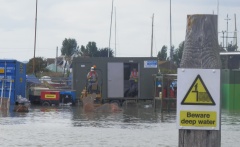
Last September saw us sniggering at Rye Harbour – watching workers renewing flood defences seeming surprised by the high Spring tide. Water lapped against cabins, swamped plant and materials, as well as drowning long standing jettys. As workers helplessly watched and waited for the waters to subside, we wondered what might happen if the tide rose higher. Now we know.
This time last week, east coast communities were battening down the sandbags before the biggest tide for decades, brought on by one of our increasingly frequent ‘extreme weather events’. Some of Sussex succumbed too. The storm surge swept up the Channel, slightly submerging some of our coast.

Wayward weather is a permanently trending topic on this island, and it takes a lot to turn the tide of conversation. However with a 60 year storm surge approaching, attention was rightly distracted to another country and the flood of feeling at the death of Nelson Mandela. Little air time was left, though, for the pockets of costly catastrophe unfolding along our coasts. For those in areas where flooding was forecast – Environment Agency alerts prevented wider harm.
Although no-one is known to have died as a result of the surge, in Norfolk cliff collapses and lost homes made headlines, along with evacuees helped out of harms’ way. However while parts of Sussex sunk under overflowing rivers – there was barely a mention even in local news. It took many minutes of delving online to find out what happened here.
Rye Harbour, Newhaven and Shoreham were, it seems, very small stories, with sea defences submerged as the tide reclaimed and wrecked some carefully managed land. Tens of homes and businesses got wet, main roads closed (albeit fairly briefly), and wildlife areas got a whole lot wilder.
In Newhaven the tide oozed over the banks of the Ouse – closing our train line for a day, with commuters diverted to buses while tracks were shored back up. Tens of homes were flooded, and the swing bridge remains damaged – a barrier to the business of the port.
The surge swallowed sleeping Shoreham too – closing the main road and airport for a while, businesses and homes got wet, and the coast road briefly closed.
At Rye Harbour, while no homes were harmed – huge damage was done to a favourite walk and cycle route as the 70 year old road to the sea was swept away – filmed by workers on the scene. Many niceties of the nature reserve are lost. In the centre of Rye flood barriers just contained the tide – with water seeping through walls at the heart of the ancient town.
In the context of recent worldwide weather emergencies this was a moderate disaster – so maybe it isn’t really news? As the highest tide happened late at night, hardly anyone saw it. The Environment Agency, responsible for flood defence, estimate in Sussex alone their work protected hundreds of homes – but some still suffered seemingly in silence.
On the day before the flood – the budget confirmed 15% cuts in our front line flood defenders. Fifteen hundred workers will be lost from the Environment Agency before next winter’s storms. In 2012 flooding cost the UK £800 million – with a weakened workforce and flood threats increasingly frequent – will these cuts come at additional cost for Sussex and beyond? Some commentators think so.
